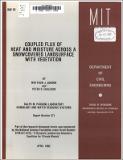| dc.contributor.author | Gordon, Matthew J. | en_US |
| dc.contributor.author | Eagleson, Peter S. | en_US |
| dc.date.accessioned | 2022-06-13T13:10:51Z | |
| dc.date.available | 2022-06-13T13:10:51Z | |
| dc.date.issued | 1982-04 | |
| dc.identifier | 271 | |
| dc.identifier.uri | https://hdl.handle.net/1721.1/143028 | |
| dc.description | Part of the research discussed herein was sponsored by the National Science Foundation under Grant, "A Dynamic Landsurface Boundary Condition for Climate Models" ATM-8114723 | en_US |
| dc.description.abstract | A theoretical study of snow accumulation and ablation in vegetated areas is presented. A one-dimensional energy and mass balance model of winter (non-transpiring) vegetation is coupled to an existing one-dimensional energy and mass balance model of the surface snowcover. A sensitivity analysis of the simulated energy fluxes is conducted with respect to canopy density, interception characteristics, and atmospheric temperature. Results indicate that the presence of vegetation can alter the heat and mass exchange between the snowcovered area and the atmosphere by at least three different processes. At lower canopy densities, the increased surface area available can increase the magnitude of the energy and mass fluxes. At higher canopy densities, the increased attenuation of ventilating wind tends to limit increases in turbulent transfer. At high canopy densities, the total shielding by the canopy of shortwave radiation and sensible and latent heat transfer to the surface from the atmosphere tends to cool the surface in warm or moderately cold weather. This causes an increase in temperature gradient and sensible heat flux from the canopy to the ventilating air. The persistence of snow on the canopy has a dramatic effect on the energy balance of the area. A snow-less canopy can become very warm and transmit more heat than a snowcovered canopy. | en_US |
| dc.publisher | Cambridge, Mass. : Ralph M. Parsons Laboratory, Hydrology and Water Resource Systems, Massachusetts Institute of Technology, Dept. of Civil Engineering | |
| dc.relation.ispartofseries | R (Massachusetts Institute of Technology. Department of Civil Engineering) ; 82-18. | |
| dc.relation.ispartofseries | Report (Ralph M. Parsons Laboratory for Water Resources and Hydrodynamics) ; 271. | |
| dc.title | Coupled Flux of Heat and Moisture Across a Snowcovered Landsurface with Vegetation | en_US |
| dc.identifier.oclc | 10782460 | |
| dc.identifier.aleph | 241275 | |
